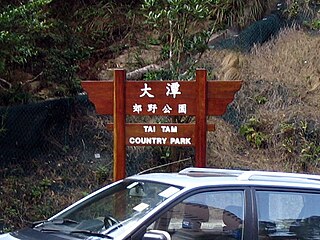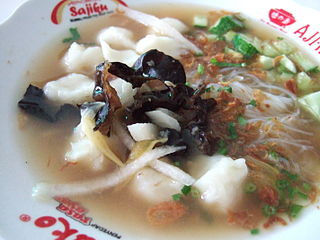Related Research Articles

Tai Tam Road in Hong Kong links the districts of Chai Wan and Stanley on Hong Kong Island. This road connects Chai Wan Road, the northern end of Shek O Road, Turtle Cove, Tai Tam and Stanley. The Tai Tam Tuk Reservoir's dam constitutes a section of the road that is particularly narrow.

Tai Lue or Xishuangbanna Dai is a Tai language of the Lu people, spoken by about 700,000 people in Southeast Asia. This includes 280,000 people in China (Yunnan), 200,000 in Burma, 134,000 in Laos, 83,000 in Thailand and 4,960 in Vietnam. The language is similar to other Tai languages and is closely related to Kham Mueang or Tai Yuan, which is also known as Northern Thai language. In Yunnan, it is spoken in all of Xishuangbanna Dai Autonomous Prefecture, as well as Jiangcheng Hani and Yi Autonomous County in Pu'er City.

Tai Seng MRT station is an underground Mass Rapid Transit (MRT) station on the Circle line, situated along the boundary of Hougang and Toa Payoh planning areas, Singapore.

Tai Dam, also known as Black Tai, is a Tai language spoken by the Tai Dam in Vietnam, Laos, Thailand, and China.

The Khamti language is a Southwestern Tai language spoken in Myanmar and India by the Khamti people. It is closely related to, and sometimes considered a dialect of, Shan.

Tai Tam Country Park is a country park in the Tai Tam area in the south end of Hong Kong Island. At 1,315 hectares, the park consists of one fifth of Hong Kong Island's land mass. During World War II, the Japanese encountered strong resistance from British defence forces here. So that the park preserves bloody memories from that period.
Pulot Tartal, pulut tai tai or pulut tekan is a Nyonya glutinous rice dessert. Originating from Melaka, Malaysia, it is also commonly served in other states in the country as well.
The Turung language is an endangered Sino-Tibetan language, closely related to Singpho, spoken in seven villages in central Assam. Many Turung people now speak Assamese.
Te Tai Rawhiti was one of the five new New Zealand parliamentary Māori electorates created in 1996 for MMP. It largely replaced its English-named predecessor, Eastern Maori, though Te Tai Rawhiti's boundary was retracted significantly in the central North Island.

Khün, or Tai Khün, also known as Kengtung tai, Kengtung Shan, is the language of the Tai Khün people of Kengtung, Shan State, Myanmar. It is also spoken in Chiang Rai Province, Thailand, and Yunnan Province, China.

The official romanization system for Taiwanese Hokkien in Taiwan is known as Tâi-uân Tâi-gí Lô-má-jī Phing-im Hong-àn, often shortened to Tâi-lô. It is derived from Pe̍h-ōe-jī and since 2006 has been one of the phonetic notation systems officially promoted by Taiwan's Ministry of Education. The system is used in the MoE's Dictionary of Frequently-Used Taiwan Minnan. It is nearly identical to Pe̍h-ōe-jī, apart from: using ts tsh instead of ch chh, using u instead of o in vowel combinations such as oa and oe, using i instead of e in eng and ek, using oo instead of o͘, and using nn instead of ⁿ.

Tekwan is a soup dish originating from the Indonesian region of Palembang. The dish contains small fish cakes made of local Musi river fish similar to pempek, and is served with savory shrimp broth, rice vermicelli, mushrooms, and sliced jicama, sprinkled with sliced fresh celery, scallions, and fried shallots.
The species Taï Forest ebolavirus is a virological taxon included in the genus Ebolavirus, family Filoviridae, order Mononegavirales. The species has a single virus member, Taï Forest virus (TAFV). The members of the species are called Taï Forest ebolaviruses.

Tai Dón, also known as Tai Khao or White Tai, is a Tai language of northern Vietnam, Laos and China.
The Phake language or Tai Phake language is a Tai language spoken in the Buri Dihing Valley of Assam, India. It is closely related to the other Southwestern Tai languages in Assam: Aiton, Khamti, Khamyang, and Turung.
Tai Laing, also known as Shan-ni, is a Tai language of Burma, closely related to Khamti and Shan. It is written in its own variant of Burmese script, and though not taught in schools, is experiencing a cultural revival, albeit still small. There is no census of speakers, but they are estimated to number around 100,000.
Tai Loi, also known as Mong Lue, refers to various Palaungic languages spoken mainly in Burma, with a few hundred in Laos and some also in China. Hall (2017) reports that Tai Loi is a cover term meaning 'mountain Tai' in Shan, and refers to various Angkuic, Waic, and Western Palaungic languages rather than a single language or branch. The Shan exonym Tai Loi can refer to:

Tai Pao, known in Vietnamese sources as Tai Hang Tong, is a Tai language of Vietnam and Laos. In Laos, it is spoken in Khamkeut District, Pakkading District, and Viengthong District of Bolikhamxai Province. Two dialects of Tai Hang Tong are distinguished: Tai Pao and Tai Yo.

Kaeng tai pla is a curry of southern Thai cuisine. Its name is derived from tai pla, a salty sauce made from fermented fish entrails, which gives the curry a strong smell and flavor.

Tai Thanh, or Tai Then, is a Southwestern Tai language of Nghe An Province and Thanh Hoa Province, north-central Vietnam.
References
- ↑ Tai at Ethnologue (18th ed., 2015) (subscription required)